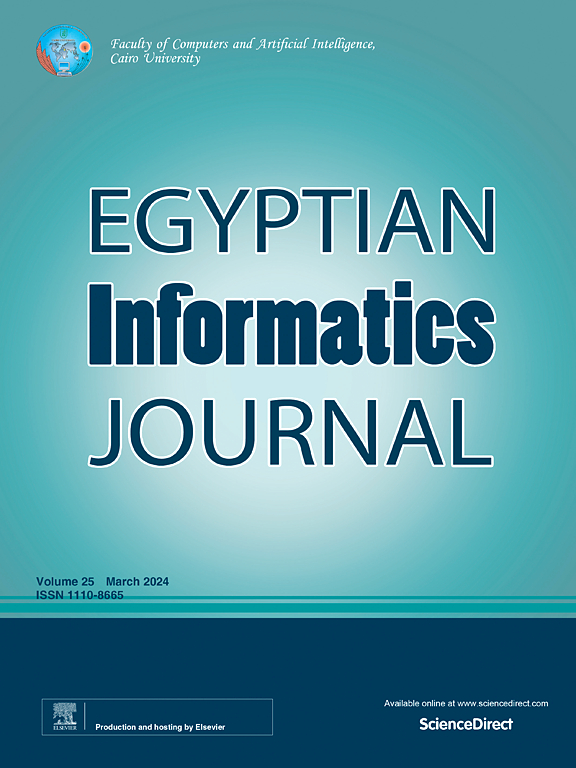EFFSIP: Efficient forest fire system using IoT and parallel computing
IF 4.3
3区 计算机科学
Q1 COMPUTER SCIENCE, ARTIFICIAL INTELLIGENCE
引用次数: 0
Abstract
The escalating issue of forest fires poses severe risks to ecosystems and human habitats, primarily due to the greenhouse effect and sudden climate changes. These fires, mostly occurring naturally, necessitate prompt detection and control. Addressing this, the paper introduces the Efficient Forest Fire System using an innovative Internet of Things (IoT) and Parallel computing (EFFSIP) solution. The EFFSIP system leverages a wireless sensor network to efficiently detect and analyze fire behavior, providing real-time data on fire spread, speed, and direction. The system processes environmental parameters such as temperature (T), relative humidity (RH), and the Chandler Burning Index (CBI) against set thresholds to enable early fire detection.
Designed for the challenging forest environment, the EFFSIP system prioritizes minimal power usage and simple components, crucial in areas with limited power resources. Its resilient design ensures that the wireless sensor network and sensor nodes withstand harsh weather and fire conditions, maintaining functionality and reliability. The system’s efficiency is enhanced through the use of Pthreads for parallel processing, allowing multiple tasks such as data collection, processing, and fire checking to be handled concurrently. This approach significantly reduces response time by processing sensor data in parallel, ensuring rapid detection and accurate prediction of fire behavior.
Field tests of the EFFSIP system in various Jordanian forest locations, including Burgish-Ajloun, demonstrated its effectiveness. The system detected a fire at 10:42 am with an initial CBI value of 32.5, which increased sharply to 97.92 as the fire progressed. Additionally, the system recorded a decrease in humidity from 53% to 22% and an increase in temperature from 28 °C to 48.6 °C. For example, the system predicted a fire at node 12 would occur in 0.477 min, allowing preemptive actions to be taken before the fire started. The system’s ability to provide real-time alerts and detailed analysis of fire spread, speed, and direction makes it a valuable tool for forest fire management. The strategic placement of sensor nodes and the use of durable components reduce the risk of system damage due to environmental extremities. The EFFSIP system offers a significant contribution to fighting forest fires, and future enhancements may include leveraging GPGPU (General-Purpose computing on Graphics Processing Units) technology to further increase computational power and system efficiency.
EFFSIP:利用物联网和并行计算的高效森林火灾系统
日益严重的森林火灾问题对生态系统和人类栖息地构成严重威胁,主要是由于温室效应和气候突变。这些火灾大多是自然发生的,需要及时发现和控制。针对这一问题,本文介绍了采用创新的物联网(IoT)和并行计算(EFFSIP)解决方案的高效森林火灾系统。EFFSIP系统利用无线传感器网络有效地探测和分析火灾行为,提供有关火灾蔓延、速度和方向的实时数据。系统根据设定的阈值处理温度、相对湿度、钱德勒燃烧指数等环境参数,实现火灾的早期探测。EFFSIP系统专为具有挑战性的森林环境而设计,优先考虑最小的功耗和简单的组件,这在电力资源有限的地区至关重要。其弹性设计确保无线传感器网络和传感器节点能够承受恶劣的天气和火灾条件,保持功能和可靠性。通过使用pthread进行并行处理,可以同时处理多个任务,如数据收集、处理和火灾检查,从而提高了系统的效率。这种方法通过并行处理传感器数据,大大缩短了响应时间,确保了快速检测和准确预测火灾行为。在包括Burgish-Ajloun在内的约旦不同森林地点对EFFSIP系统进行的实地测试证明了其有效性。该系统在上午10点42分检测到火灾,初始CBI值为32.5,随着火灾的发展,CBI值急剧上升至97.92。此外,该系统记录的湿度从53%下降到22%,温度从28°C上升到48.6°C。例如,系统预测节点12将在0.477分钟内发生火灾,允许在火灾发生前采取先发制人的行动。该系统能够提供实时警报和详细分析火灾蔓延、速度和方向,使其成为森林火灾管理的宝贵工具。传感器节点的战略性放置和耐用组件的使用降低了由于环境极端而导致系统损坏的风险。EFFSIP系统为扑灭森林火灾做出了重大贡献,未来的增强可能包括利用GPGPU(图形处理单元通用计算)技术来进一步提高计算能力和系统效率。
本文章由计算机程序翻译,如有差异,请以英文原文为准。
求助全文
约1分钟内获得全文
求助全文
来源期刊

Egyptian Informatics Journal
Decision Sciences-Management Science and Operations Research
CiteScore
11.10
自引率
1.90%
发文量
59
审稿时长
110 days
期刊介绍:
The Egyptian Informatics Journal is published by the Faculty of Computers and Artificial Intelligence, Cairo University. This Journal provides a forum for the state-of-the-art research and development in the fields of computing, including computer sciences, information technologies, information systems, operations research and decision support. Innovative and not-previously-published work in subjects covered by the Journal is encouraged to be submitted, whether from academic, research or commercial sources.
 求助内容:
求助内容: 应助结果提醒方式:
应助结果提醒方式:


